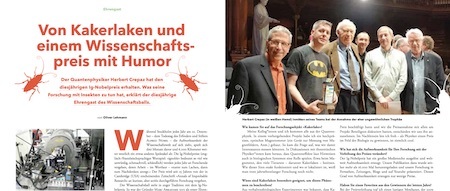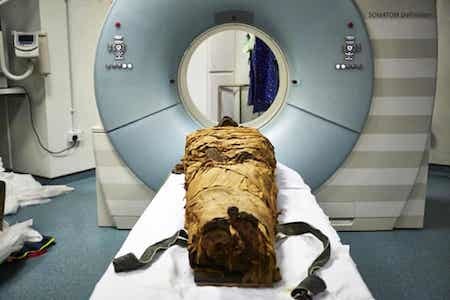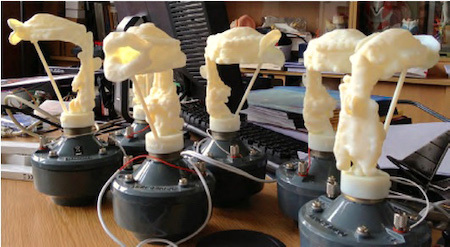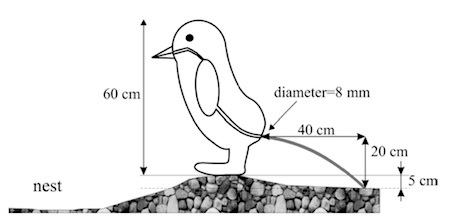Marc Abrahams's Blog, page 127
February 3, 2020
Sopranos (but not tenors) live longer [study]
 Which (opera) singers tend to live longer – sopranos, contraltos, tenors or basses? This question was formally investigated in 2011 by researchers Abel EL, Kruger MM and Pandya K. of the Departments of Obstetrics and Gynecology and Psychology, Wayne State University, Detroit, US.
Which (opera) singers tend to live longer – sopranos, contraltos, tenors or basses? This question was formally investigated in 2011 by researchers Abel EL, Kruger MM and Pandya K. of the Departments of Obstetrics and Gynecology and Psychology, Wayne State University, Detroit, US.
Pertinent answers may be found in : Sopranos but not tenors live longer. (in Aging Male. 2012 Jun;15(2):109-10)
Coming Soon : If you’re musically inclined, and have ambitions to live for a long time, which musical instrument should you choose to learn?

January 31, 2020
Further adventures of a guy who partially uncooked an egg
“We showed that you could uncook the egg and then cook it again. We used mechanical energy to drive the proteins into the correct shape. I became really interested in how you transform things. How do you change chemicals and do it on a massive scale?”
UCI [University of California, Irvine] News profiles Ig Nobel Prize-winner Greg Weiss, with the headline: “The Speed King—Professor Greg Weiss and collaborators have developed a method of detecting cancer molecules within minutes, a breakthrough that could save lives.”

“Gregory Weiss of UC Irvine has discovered how lysozymes in tears and saliva work to destroy harmful bacteria.” photo : Steve Zylius/UC Irvine Communications

January 29, 2020
The Sounds of Trees When Hit by Rocks Thrown by Chimps
What are the sounds that come from trees when those trees are hit by rocks thrown by chimpanzees? A new study addresses that question:
“Chimpanzees use tree species with a resonant timbre for accumulative stone throwing,” Ammie K. Kalan, Eleonora Carmignani, Richard Kronland-Martinet, Sølvi Ystad, Jacques Chatron and Mitsuko Aramaki, Biology Letters, 18 December 2019, Article ID:20190747.
The authors, at the Max Planck Institute for Evolutionary Anthropology, Germany, and Aix Marseille University, France, explain:
We conducted field experiments to test whether impact sounds produced by throwing rocks at trees varied according to the tree’s properties. Specifically, we compared impact sounds of AST [accumulative stone throwing] and non-AST tree species. We measured three acoustic descriptors related to intrinsic timbre quality, and found that AST tree species produced impact sounds that were less damped, with spectral energy concentrated at lower frequencies compared to non-AST tree species. Buttress roots in particular produced timbres with low-frequency energy (low spectral centroid) and slower signal onset (longer attack time). In summary, chimpanzees use tree species capable of producing more resonant sounds for AST compared to other tree species available.
They touch on the question of whether this be music:
Studies on how variation in the sound-production properties of different tree species might affect animal behaviour are lacking despite observations of chimpanzees and palm cockatoos drumming on trees. In comparison, humans fashion a variety of wooden musical instruments whereby the quality of sound for each instrument is dependent upon the intrinsic sound properties of the tree species used, otherwise referred to as ‘timbre’. In particular, it has been shown that mechanical properties of wood species such as internal friction, density and the longitudinal modulus of elasticity are important aspects that instrument makers take into account when selecting tree species.

January 28, 2020
The Madman Theory – tested for the first time [new study]
The Wikipedia entry for the Madman Theory informs :
“The madman theory is a political theory commonly associated with U.S. President Richard Nixon’s foreign policy. He and his administration tried to make the leaders of hostile Communist Bloc nations think Nixon was irrational and volatile. According to the theory, those leaders would then avoid provoking the United States, fearing an unpredictable American response.”
The theory, however, has not, until now, been empirically ‘tested’ in a ‘large-N’ context (that’s to say with a large number of leaders who were, or are, regarded, by some, at least in part, as ‘mad’).
A new article in the British Journal of Political Science, from Professor Roseanne McManus at Penn State University, US, examines the Madman Theory in some depth.
“This article offers the first large-N test of this theory. The author introduces an original perception-based measure of leaders’ reputations for madness, coded based on news reports, and analyzes its effect on both general deterrence and crisis bargaining. The study also tests several hypotheses about the conditions under which perceived madness is expected to be more or less helpful. The author finds that perceived madness is harmful to general deterrence and is sometimes also harmful in crisis bargaining, but may be helpful in crisis bargaining under certain conditions. The analysis suggests that the harmful effect of perceived madness results from a commitment problem.”
Here is a partial view of a table from the article showing leaders most frequently coded as having a slight madness reputation.
Research research by Martin Gardiner

January 27, 2020
Ig Nobel winner / cockroach magnetizer is guest of honor at the Vienna Science Ball
The Ig Nobel cockroaches—Herbert Crepaz won the 2019 Ig Nobel prize in the category biology, honouring achievements that make people laugh, and then think. The Austrian quantum physicist, who works at the Centre for Quantum Technologies at the National University of Singapore, discovered that dead magnetized cockroaches behave differently than living magnetized cockroaches. Crepaz has developed a highly precise magnetometer, which he wants to apply to interesting questions. And quantum effects may play a role in biological systems, such as magnetoreception – a sense present in many animals, but so far not understood. Crepaz is guest of honour at this year’s Ball of Sciences….
Details are in Das Ballmagazin 2020 | Wiener Ball der Wissenschaften 2021—the official magazine of the Vienna Science Ball. [You can download and read the entire magazine. (It’s written in German. The text in this blog-posted is machine-translated.]

The magazine also reports:
The science ball is closely related to the Ig Nobel Prize. In 2015, the founder Marc Abrahams was the first guest of honor to meet at the ball. In his short lecture at midnight he spoke about Vienna’s sciences and their impact on the world.
The Austrian anthropologist Elisabeth Oberzaucher, who is now a member of the science cabaret group Science Busters, also received the Ig Nobel Prize the following year – and entered the arena as a ball ambassador. Oberzaucher received her award for an investigation through which they have the legendary joy of procreation of a Moroccan sultan. This is said to have 888 children have fathered man. That works out – with sex twice a day.

January 24, 2020
What Mummy Said, Sort of, 3000 Years Later
This report sounds like it is saying that the authors managed to hear what a person who became a mummy sounded like before he became a mummy.
The report is: “Synthesis of a Vocal Sound from the 3,000 Year Old Mummy, Nesyamun ‘True of Voice’, ” D.M. Howard [inventor of the Vocal Tract Organ], J. Schofield, J. Fletcher, K. Baxter, G.R. Iball, and S.A. Buckley, Scientific Reports, vol. 10, no. 45000, 2020. The authors, at Royal Holloway, University of London, UK; the University of York, UK; Leeds General Infirmary, UK, and the University of Tübingen, Germany; report:
“The sound of a 3,000 year old mummified individual has been accurately reproduced as a vowel-like sound based on measurements of the precise dimensions of his extant vocal tract following Computed Tomography (CT) scanning, enabling the creation of a 3-D printed vocal tract. By using the Vocal Tract Organ, which provides a user-controllable artificial larynx sound source, a vowel sound is synthesised which compares favourably with vowels of modern individuals.”
The Vocal Tract Organ
What is a Vocal Tract Organ? The Bibliolore blog talked about that, so to speak, in 2015:
“The vocal tract organ is a new musical instrument that consists of three-dimensional (3D)-printed vocal tracts (throat and mouth) for individual vowels sitting on loudspeakers to enable static vowel sounds to be produced. The acoustic excitation from the loudspeakers is a synthesized version of the typical waveform produced by the vibrating human vocal folds during pitched sounds, which enables the instrument to be played from a keyboard….”
BONUS (not necessarily related): Animal squawks squeaks and songs (with helium)

January 22, 2020
The mystery of how some animals lock themselves into place
Benno Meyer-Rochow, who won an Ig Nobel Prize in 2005 for calculating the pressures produced when penguins poo [see diagram, below] is now investigating a different kind of biological mystery.
Meyer-Rochow wrote an essay that begins:
You can lock arms with someone, you can lock on to something or be locked in or even be locked up or locked out. But this essay is about animals that possess locking mechanisms. In the tropical waters of Ascension Island in the South Atlantic Ocean, for example, I once caught a pair of matchbox-sized trigger fish and observed their behaviour in my aquarium on board of the research vessel “Walter Herwig”. These denizens of the tropical seas as well as their cousins, the file fishes, can wedge themselves into rock cracks and coral crevices in such a way that it is virtually impossible to dislodge them by pulling at their tails.
You might think that these fish must be mighty strong, but in reality they hardly use any energy at all in this process of “locking in”. Their first dorsal fin ray is a spine that possesses a groove on the backside; but when fully erect a smaller second spine behind the first one is pushed home into the groove of the spine in front, so that the first bigger spine cannot be depressed by external forces, except when the second smaller one is retracted first. A very fine and effective device that is….

Sad news: Terry Jones is dead
Terry Jones has died. His achievements as a Monty Python, and as a writer, director, and actor in other realms, are well and duly celebrated. He was a very nice and good person. And rather funny.
We were lucky to have collaborated with him on some small things. Here are two performances of bad poetry by William McGonagall. The second video features Terry with Dr. Elena Bodnar, Ig Nobel Prize-winning inventor of the Emergency Bra, a device that in an emergency can be quickly separated into a pair of protective face masks:
Terry was going to be the English language narrator on the Ig Nobel Operas television series, a project that was launched with great excitement about eight years ago but (in the tradition of the television industry!) disintegrated for nonsensical business reasons.

Podcast Episode #202: “Sneezing and a Full Stomach”
Sneezing on a Full Stomach, Mustache Wax, Red Hippo Sweat, The Impossible Expertise of Self-Perceived Expertise, some 2012 Ig Nobel Prize Winners, and Walking in the City.
In episode #202, Marc Abrahams shows some unfamiliar research studies to Melissa Franklin, Richard Baguley, Robin Abrahams, Jean Berko Gleason, and Nicole Sharp. Dramatic readings and reactions ensue.
Remember, our Patreon donors, on most levels, get access to each podcast episode before it is made public.
1. Melissa Franklin encounters:
“Autosomal Dominant Sneezing Disorder Provoked by Fullness of the Stomach” A.S. Teebi and Q.A. Al-Saleh, Journal of Medical Genetics, vol. 26 , 1989 , pp. 539-40.
“An Unusual Finding on Routine Dental Pan-Oral Tomography,” S. Lloyd, V.R. Talati, and J.P. Ward, British Dental Journal, vol. 176, no. 4, February 19, 1994, pp. 144-6.
“Perioral Dermatitis Secondary to the Use of a Corticosteroid Ointment as Mustache Wax,” E.K. Edwards Jr. and E.K. Edwards Sr., International Journal of Dermatology, vol. 26, no. 10, December 1987, p. 649.
“Islam, Teaching Dermatologic Surgery, and Porcine Parts,” Lawrence M. Field, Dermatologic Surgery, vol. 27, no. 6, June 2001, pp. 608-9.
2. Richard Baguley encounters:
“Refined Structure of Hipposudoric and Norhipposudoric Acids, Pigments of the Red Sweat of the Hippopotamus,” Takatoshi Matsumoto, Yoko Saikawa, Masaya Nakata, and Kimiko Hashimoto, Chemistry Letters, epub 2015.
3. Robin Abrahams encounters:
“When Knowledge Knows No Bounds — Self-Perceived Expertise Predicts Claims of Impossible Knowledge,” Stav Atir, Emily Rosenzweig, David Dunning, Psychological Science, vol. 26 no. 8, 2015, pp. 1295-1303.
“Unskilled and Unaware of It: How Difficulties in Recognizing One’s Own Incompetence Lead to Inflated Self-Assessments,” David Dunning and Justin Kruger, Journal of Personality and Social Psychology, vol. 77, no. 6, December 1999, pp. 1121-34.
4. Jean Berko Gleason encounters:
“Leaning to the Left Makes the Eiffel Tower Seem Smaller: Posture-Modulated Estimation,” Anita Eerland, Tulio M. Guadalupe and Rolf A. Zwaan, Psychological Science, vol. 22 no. 12, December 2011, pp. 1511-14.
The SKN Company (Details.)
“SpeechJammer: A System Utilizing Artificial Speech Disturbance with Delayed Auditory Feedback,” Kazutaka Kurihara, Koji Tsukada, arxiv.org/abs/1202.6106. February 28, 2012.
“Neural correlates of interspecies perspective taking in the post-mortem Atlantic Salmon: An argument for multiple comparisons correction,” Craig M. Bennett, Abigail A. Baird, Michael B. Miller, and George L. Wolford, poster, 15th Annual Meeting of the Organization for Human Brain Mapping, San Francisco, CA, June 2009. It was later published as: “Neural Correlates of Interspecies Perspective Taking in the Post-Mortem Atlantic Salmon: An Argument For Multiple Comparisons Correction,” Craig M. Bennett, Abigail A. Baird, Michael B. Miller, and George L. Wolford, Journal of Serendipitous and Unexpected Results, vol. 1, no. 1, 2010, pp. 1-5.e
Johan Pettersson (see various news reports).
5. Nicole Sharp encounters:
“Walking and rhythmicity: Sensing urban space,” by Filipa Matos Wunderlich, published in the Journal of Urban Design, in 2008.
Bruce Petschek, Audio Engineer
Jon Shedler, Audio Engineer
Seth Gliksman, Production Assistant
Available on Spotify, Apple Podcasts, Overcast, Google Podcasts, AntennaPod, BeyondPod and elsewhere!

January 20, 2020
“Big Men” in leadership roles [new study]
How does body weight and size affect the perceived persuasiveness of ‘leaders’ (when the ‘leader’ is a man) ? This question has recently been examined by three professors from the Dyson School of Applied Economics and Management, Cornell University, US. Professor Kevin Kniffin and Professor Vicki Bogan, along with faculty colleague Professor David Just (also now at Universita degli Studi di Catania, Italy), present a series of six studies :
“[…] in which we find that the anthropological concept of “big men” can carry literal meaning–in relation to “big”ness and “men”– in contemporary settings.”
Alongside the finding, the authors caution that prospective ‘leaders’ should exercise restraint with the idea of deliberately putting on more weight in order to enhance their gravitas.
“Our findings do not suggest that men should acquire more weight to be viewed as more persuasive; […]”
As can clearly be seen in the graph below :
Reference : “Big men” in the office: The gender-specific influence of weight upon persuasiveness in PLOS ONE, Nov., 2019.
Note : PLOS ONE is a rebranded version of the journal previously known as PLoS ONE. The diminutive ‘o’ in the original logo having been replaced, in 2012, by a more imposing big ‘O’.
Research research by Martin Gardiner

Marc Abrahams's Blog
- Marc Abrahams's profile
- 14 followers









